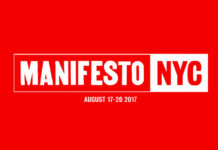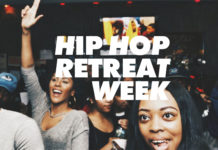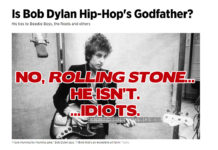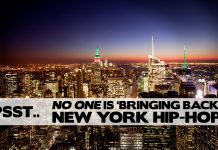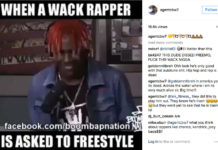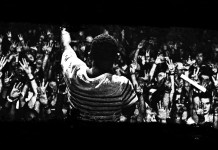Too many people, particularly those who long for New York hip hop to “come back,” waste too much time complaining about today’s hip hop, when they could be using that time to discover good hip hop music from today’s New York-area artists.
Instead, they grumble about the current style and substance of mainstream hip hop, the R&B-influenced sound of Drake for example, or the lyrically simplistic style of some Southern rappers and the overall lack of traditional New York flavored hip hop on radio, stating with repeated disgust that “real” hip hop is dead and gone.
They lament the loss of the New York sound, nostalgically pining for 1990’s boom-bap sound that many of them grew up on, screwing up their face and dismissing any “Top 5, Dead or Alive” list that doesn’t include Jay-Z, B.I.G., Nas and Jadakiss.
All of which are fine opinions, but let’s be real about real.
Saying you want “real hip hop” back, is stupid. There is no “real” hip hop.
What you really mean to say, is that you miss traditional, New York sounding hip hop, a mix of grit and poetry, over beats that utilize chopped up samples, or soul music loops, accompanied by hard hitting, crispy drum sounds, for the most part floating around 88-92 beats per minute. A type of hip hop that was a nod to rap music’s early days, but with updated storytelling, increased lyrical prowess and advanced musical complexity. A hip hop that you once enjoyed while laying back, puffing an L, feeling an emotional twinge of invincibility tied to a feeling that these slick-talking rappers and hard-hitting beatsmiths were just like you. Artists that somehow packaged and delivered the collective feeling of living in New York into sounds and songs that stuck with you then, and continue to evoke feelings of euphoric nostalgia ever since.
THAT was “real” hip hop, right? What you hear on the radio today, that’s not “real,” right?
Wrong.
The problem is, you are selfish.
But it’s understandable. You are focused on a very short amount of time in hip hop’s lifespan and because it was a particularly formative time for you musically, you feel a certain way about that time period, and the music contained therein.
Your assertion that 1990s New York hip hop is covered under the umbrella of “real” hip hop, whereas “today’s” hip hop isn’t, is wrong, and is created by a combination of your particular taste in music and your respect for hip hop history, but mainly because of your psychological bias.
To be fair, it’s an age-old argument. When asked to pinpoint the best decade for music, people overwhelmingly respond by choosing a decade from their youth. This generally holds true across all genres and generations.
Your prejudice toward 1990s New York hip hop exists because that was likely the time that you were fully immersed in music, when music not only was something listened to constantly, but something to connect to.
Since then, life got in the way, and while hip hop evolved, you held on to your personal tastes, your preferred style. You listened to vinyl and cassettes and CDs in your collection. You ported over your songs to your iPod and replayed certain albums you had forgotten about. Sure, you still listened to what was new, but the time that you previously dedicated to absorbing everything new, became fractured.
You lost the ability to connect to new music, partially because you grew older. Mainstream music of course is specifically engineered to cater to a younger crowd, and because your time and energy was being spent elsewhere, your inclination to seek out music more along the lines of your musical tastes diminished as well.
Plus, you still had your favorite joints up in the iPod.
But young people, entering their own formative music-listening years, were still being hand-delivered hip hop, though what was now on the radio sounded a lot different than just a few years ago when you were coming up.
To be real, this was just a continuation of the evolution of hip hop, beyond your personal glory days, just as it had evolved from the Sugar Hill Gang-style rap from half a generation before you.
Now, a new batch of kids started immersing themselves with the prevalent hip hop of the day, which to them, no less “real” than the music you got into.
I mean, before we can criticize today’s hip hop as any less “real,” we must take an objective look at how different Mobb Deep or Snoop Dogg was from the Treacherous Three or the Fat Boys.
Understand the point?
Look, I know what you mean. But you have to get over it. The fact is, Drake IS real hip hop. So is Waka Flocka Flame. So is Tupac. And Biggie. And Run-DMC. And MC Lyte. And Kurtis Blow. And Melle Mel.
But to a 15 year old who grew up in Atlanta his whole life, having been exposed to the type of hip hop he is regularly exposed to, there is no way you can contend that to him, and others like him, his hip hop is not “real” hip hop.
It’s all “real.” It’s not all “real good,” but not every New York rapper in the 90s was either.
And don’t forget that in the 1990s, there were many less distribution channels. Less geographical hubs of rap music. New York hip hop was dominant in the 1990s because there were few places labels were culling hip hop talent from in the 1990s.
Once they figured out that there was an entirely different, underserved and undercapitalized market, the distribution companies (labels, radio, media) flocked to these untapped markets.
While it is true that for the most part they have yet to return, it does not mean that New York hip hop is dead.
It also does not mean that good New York hip hop has to sound exactly like it did in the 1990s.
To 1990s New York hip hop fans: I feel you. I am one of you. I am as pro-New York hip hop as anyone, but to be pro-New York hip hop does not mean we have to be anti-everywhere-else hip hop.
I also came up during the New York hip hop “Golden Era” of the 1990s but I am not stubbornly stuck in the musical past. By being open-minded to the evolution of hip hop, not wasting time crying over spilled rap milk, I have found plenty of New York-area artists of today, who satisfy my purist, old-school hip hop soul.
New York has always been a progressive city in terms of music, from jazz to musical theater, from punk to hip hop, magically infusing its artistic residents with an ability to create or advance music in ways no other place can. This continues today, as the bubbling New York hip hop underground is the center of our entire journalistic effort, and in that effort, we continuously come across sparks of new talent, artists who possess that same nod to rap’s earlier days, also with an updated storytelling, increased lyrical prowess and advanced musical complexity.
They are in your city. Some live on your block. They perform at venues all throughout the city, and for a few dollars, you can see them perform. Sure you’ll have to sit through a lot of mediocre artists first, but at least, unlike the radio, there’s a payoff at the end of these efforts, delivered by an artist of today that will at the same time invoke a pleasant feeling of nostalgia, mixed with a feeling that you’re hearing something new and fresh.
And if you let it, it will feel very, very real.
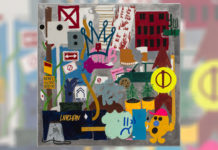
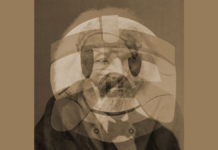
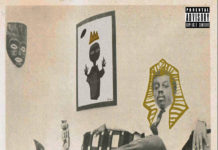
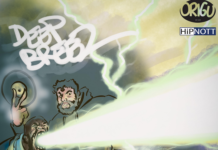

![The Underachievers – Crescendo [VIDEO]](https://www.birthplacemag.com/wp-content/uploads/2017/08/hqdefault-2-218x150.jpg)


![Fat Joe & Remy Ma ft. The-Dream – Heartbreak [VIDEO] Fat Joe Remy Ma The Dream - Heartbreak Video](https://www.birthplacemag.com/wp-content/uploads/2017/05/fat-joe-remy-ma-218x150.jpg)
![JSWISS featuring Chandanie – LML [VIDEO] JSWISS featuring Chandanie - LML [VIDEO]](https://www.birthplacemag.com/wp-content/uploads/2017/05/JSWISS-218x150.jpg)
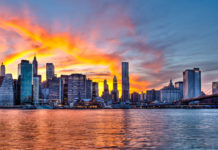
![Akinyemi Ends Summer With “Summers” EP Release Show [9-17-17] Akinyemi 'Summers' EP release show at Brooklyn Bazaar](https://www.birthplacemag.com/wp-content/uploads/2017/09/summers-featured-218x150.jpg)
![4th Annual NYC VS EVERYBODY Yacht Party [9/16/17] #VSYacht 4th annual NYC VS Everybody Yacht Party#VSYacht](https://www.birthplacemag.com/wp-content/uploads/2017/09/vsyacht-218x150.jpg)
